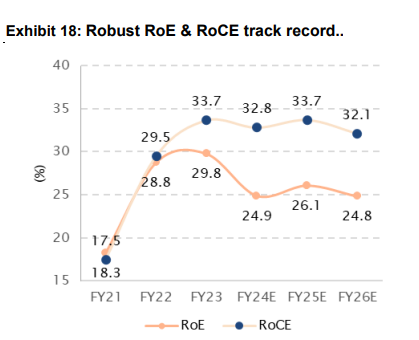Shivalik Bimetals Q2 concall highlights -
Sales - 128 vs 118 cr
EBITDA - 29 vs 27 cr ( margins @ 23 vs 23 pc )
PAT - 20 vs 19 cr
Manufacturing facilities -
Plant 1 @ Solan - for Electron Beam Welded ( a hi-tech process ) Shunt Resistors, peak revenue capacity - 700 cr
Plant 2 @ Solan - for thermostatic bimetal strips ( uses complex diffusion bonding techniques ), peak revenue capacity - 600 cr
Plant 3 @ Solan - for electrical contacts ( uses complex and specialised bonding processes ), peak revenue capacity - 300 cr
Total revenue potential of Rs 1600 cr vs current topline run rate of about 500 cr. Aim to hit these potential figures inside next 5 yrs
Capex lined up - 20 to 30 cr (only) - for improving productivity and cost optimisations from FY25-26
Product applications -
Shunt Resistors - regulate the flow of current in an electrical circuit. Used to measure, sense the flow of current and create a path of least resistance for the electrical current to pass. Used in - smart meters, EVs, Energy storage, power modules
Thermostatic Bimetals - critical components used in overload protection devices. Used in - switchgear, electrical appliances, medical devices, automobiles
Electrical Contacts - these are connecting points when a switch is turned on/off. Made of different types of precious metal alloys. Used in smart meters, switchgears, wires and accessories, electrical appliances
Sales break up -
Geography wise -
Export - 65 pc
Domestic - 35 pc
Product wise -
Shunts - 43 pc ( started just 5 yrs ago )
Bimetals ( including contacts )- 57 pc
Industry wise growth rate projections from 2023 to 30 -
Shunt resistors - 14 pc CAGR !!!
Bimetals - 7 pc CAGR
Electrical contacts - 7 pc CAGR
Formed a JV with International leader - Metalor technologies ( Swiss Company - Japanese parentage ) to make Electrical contacts ( announced on 30 Nov 23 ) - should lead to significant volumes uptick in the Silver contacts segment
FY 24’s slowdown should be a temporary phenomenon due current trend of de-stocking ( a lot of over stocking happened during the COVID times ). Long term growth guidance remains intact. Should see a descent pick up wef Q1 FY 25
Global slowdown ( due De-stocking ) being countered nicely by increased domestic demand, demand from Asia, Australia
India should be producing around 2 cr smart meters per year. Most of the component supply for these smart meters should get procured from Indian vendors under the make in India project
Breakdown of sales of Shunt Resistors -
40 pc from - smart meters ( out of this 15 pc is domestic demand )
40 pc - EVs
20 pc - energy storage systems
Share of fixed costs @ 11-13 pc. As revenues grow, operating leverage should kick in
Seeing some pickup in demand for Shunt resistors for smart meters. Hope to double sales of shunt resistors from the smart meters segment in FY 25
Should get back to 50:50 sales breakdown wrt Shunts : Bimetals sometime next yr. Shunts is a higher margin By and large, exports shall be the major driver of growth for the company over the medium to long term. This also is a key risk - IMO
If exports don’t pick up as expected, management still sees a growth of 12-15 pc in next FY. If exports pick up - as expected, growth in next FY can be as high as 40 pc
5G roll out should help the company as their products go into critical energy storage applications
Disc: holding, biased, not SEBI registered







